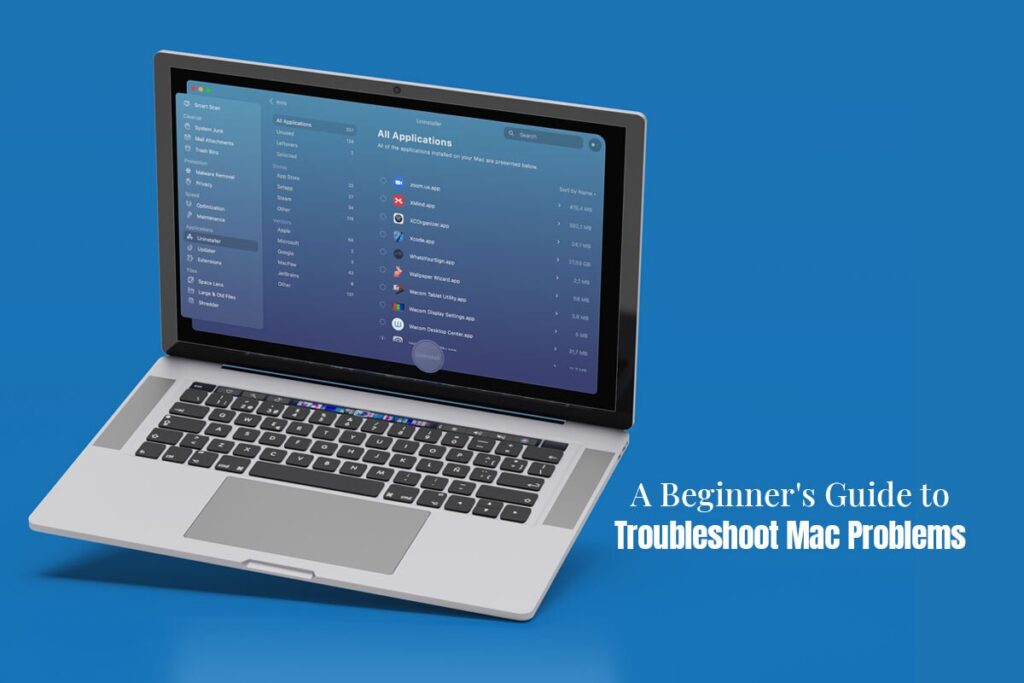Problems are omnipresent. Even if you invest in a Mac computer, issues will follow you around. Of course, Apple works hard to offer regular updates for minor glitches, such as software bugs and security vulnerabilities. But Macs are machines at the end of the day. No matter how sophisticated its hardware and software are, they show signs of old age or indicate trouble in paradise when running too many resource-intensive processes.
Some of the common problems complained about by Mac users are:
- Slow system performance, which might be caused because the machine is a few years old or there are too many processes in the background.
- Macbook flashing folder with question, which is a serious issue and means your device cannot find a startup disk. This might also mean there is no macOS on the designated startup disk.
- Excessive battery drainage, which might be caused because the battery needs replacement or you are multitasking way too heavily for your system to keep up.
- Screen flickering, which is usually caused due to inconsistencies with the display settings or the display cable is faulty.
- The spinning beach ball is one of the most annoying issues caused because one or two apps are misbehaving, and your system has frozen.
These common issues might be caused because of a number of factors, but they all can be solved, more or else, by implementing the following fixes. Other problems encountered on your Mac can also be resolved if you memorize this troubleshooting guide.
- Reboot
Rebooting gives your Mac a fresh start and solves issues like unresponsive apps, processes, and accessories. Typically, you can solve all minor and major problems by simply restarting your Mac.
However, you may lose unsaved work progress in this process.
- Force quit
Force quitting is another simple solution to resolve misbehaving, unresponsive apps. Press Command + Option + Escape to bring up the force quit menu and then quit the unresponsive applications. Wait for some time before relaunching the app to see if the issue is solved.
- Keep macOS up-to-date
Getting up-to-date bug fixes and protection is possible if you regularly upgrade your macOS version. Your Mac will typically notify you whenever there’s an update available. You can set up automatic updates or manually update your macOS software to harness the latest performance enhancements, bug fixes, and security patches.
Additionally, you can check for app updates. Keeping the apps and processes up-to-date is as essential as updating the macOS version.
- Boot in Safe mode
Sometimes, apps and software may cause issues in the background. It can be extremely cumbersome to pinpoint the program or app causing problems. Hence, boot up in Safe mode. In this mode, your Mac will start with only the essentials. The apps listed in Login Items will not load in this mode. Also, while in Safe mode, your computer will quickly assess the startup disk and repair corrupt file systems, if any.
On an Apple Silicon Mac, you can enter Safe mode by holding the power button when your device is restarting and then choosing the startup disk. Hold the Shift key and select Continue in Safe Mode.
On Intel-based Macs, hold the Shift key when your computer is restarting and let go of the key when the Apple logo appears.
- Reset the SMC
Resetting the SMC can solve several problems like not displaying video, not starting up, sleep issues, battery charging issues, fan noise issues, etc. The SMC can only be reset on Intel-based Macs because Apple Silicon versions do not have SMC.
You can reset the SMC by shutting down your Mac, disconnecting the power cord if it is a desktop Mac >, and waiting for fifteen seconds before plugging it back in. After five seconds, turn on your computer.
If you use a laptop with a T2 chip, shut down the computer > hold the power button for ten seconds, and release it > press the power button again after a few seconds to start the computer.
Is this not working? If so, you can click the Apple menu > choose Shut Down > hold the Control + Option + Shift keys for seven seconds > hold the power button along with the other keys for another seven seconds > release all four keys and wait a few seconds before turning on your Mac.
Besides these, you can also try resetting NVRAM/PRAM, running Apple Diagnostics, toggling off and on Wi-Fi and Bluetooth, uninstalling and reinstalling macOS, factory resetting your device, etc.
In conclusion, no computer is perfect; the same goes for Apple Mac. Mac computers are one of the best in the market, but they are not flawless. Hence, stay prepared for eventualities. It is essential to create a maintenance regime to keep dust and debris from accumulating and blocking the vents and preventing dust from causing keyboard issues. However, if you are at a loss, do not think twice before seeking assistance from Apple Support.

